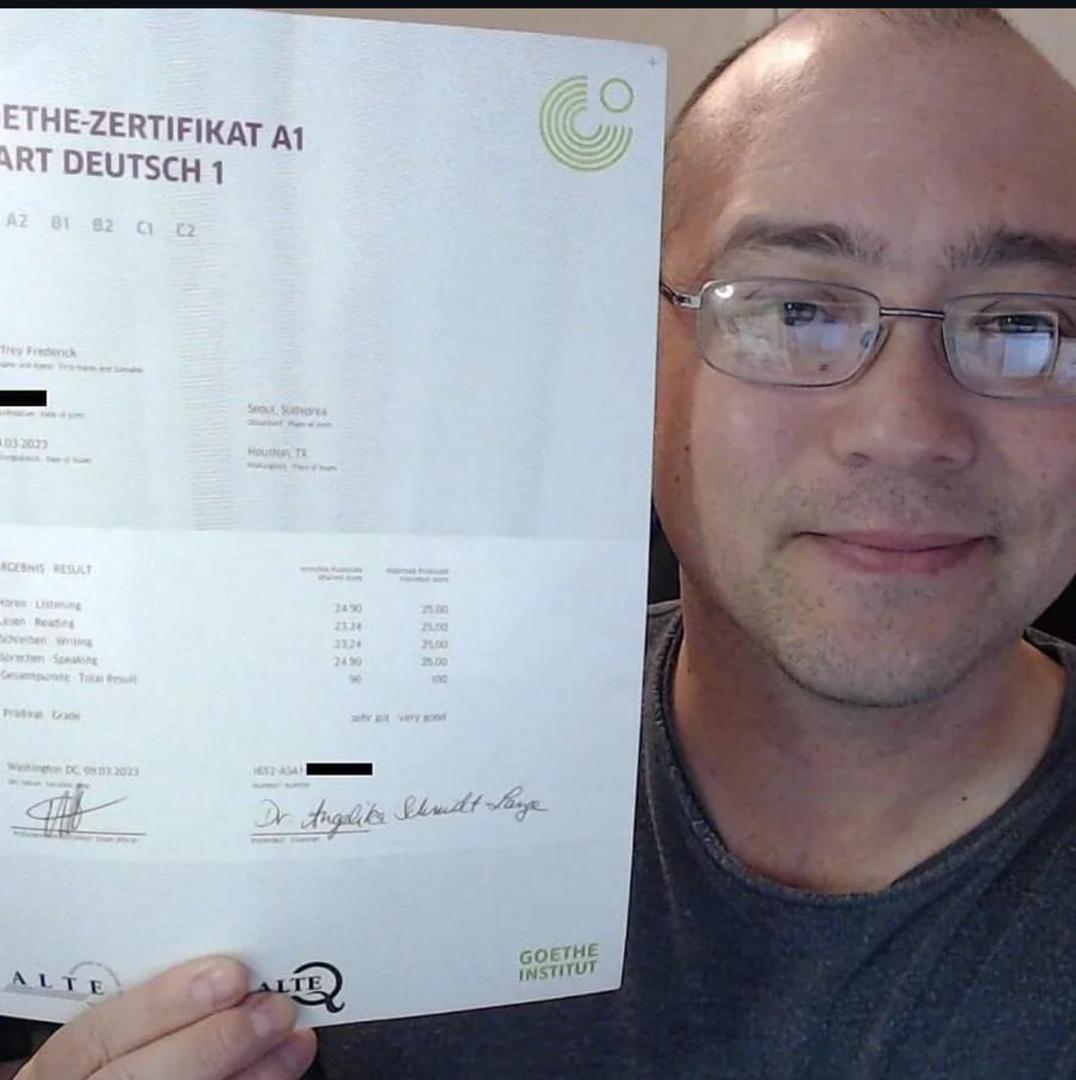It Is The History Of Ösd Exam In 10 Milestones
페이지 정보

본문
Understanding the ÖSD Exam: A Gateway to Proficiency in German
The ÖSD (Österreichisches Sprachdiplom deutsch test) exam is a standardized language efficiency test developed to evaluate and accredit German language skills. Acknowledged internationally, the ÖSD exam accommodates various students, ranging from beginners to sophisticated speakers. This post intends to offer a helpful introduction of the ÖSD exam, detailing its structure, levels, preparation techniques, and regularly asked concerns.
The Importance of the ÖSD Exam
In a globalized world where proficiency in several languages is highly valued, the ÖSD exam serves numerous crucial functions:
Certification of Language Proficiency: The ÖSD exam uses certificates that are recognized in Austria and other German-speaking nations, facilitating job opportunity and university admissions.
Standardized Assessment: The exam offers a standardized assessment of language abilities, sprachniveau österreich - www.hulkshare.com - which can be beneficial for scholastic and expert purposes.
Structured Learning Path: The ÖSD uses a clear structure for language learners, directing them toward accomplishing particular language objectives through a structured curriculum.
Structure of the ÖSD Exam
The ÖSD exam is divided into various levels lined up with the Common European Framework of Reference for Languages (CEFR). Each level tests four essential language abilities: listening, reading, composing, and speaking.
Levels of the ÖSD Exam
The ÖSD uses examinations at six levels, representing the CEFR framework:
A1: Beginner
A2 Zertifikat Deutsch: Elementary
B1: Intermediate
ösd b2: Upper Intermediate
C1: Advanced
C2: Proficiency
Each level has specific requirements and expectations, permitting prospects to concentrate on ideal materials and practices based on their efficiency.
 Exam Components
Exam Components
The ÖSD exam is divided into four distinct components:
Listening Comprehension: Candidates listen to different audio products (conversations, interviews, and presentations) and address comprehension concerns.
Reading Comprehension: This area includes texts of differing lengths and intricacies, accompanied by questions that evaluate understanding and interpretation.
Writing: Candidates are required to produce written texts (letters, essays, or reports) depending upon the level, showing their ability to communicate details and arguments successfully.
Speaking: The speaking part normally involves a conversation with an examiner, a2 zertifikat Deutsch needing candidates to show fluency, pronunciation, and grammatical precision.
Preparation for the ÖSD Exam
Getting ready for the ÖSD exam needs a tactical technique, including various research study approaches and resources. Here are some efficient strategies:
Research study Methods
Enlist in a Language Course: Structured courses can offer guidance and a methodical method to language learning.
Experiment Sample Tests: Using main ÖSD sample products can acquaint prospects with the exam format and question types.
Sign Up With a Study Group: Collaborating with peers can improve learning through shared understanding and accountability.
Usage Language Learning Apps: Mobile applications can support language acquisition, offering vocabulary practice and interactive workouts.
Resources
Books and Workbooks: a2 zertifikat deutsch Choose materials that align with the target level of the ÖSD exam.
Online Platforms: Websites committed to language knowing often offer complimentary resources, including grammar exercises and vocabulary lists.
Tutoring: Personal direction from skilled instructors can provide customized feedback and targeted practice.
Tips for Success
Set Realistic Goals: Break down the preparation process into manageable milestones.
Engage with Native Speakers: Regular interaction with native German speakers can enhance conversational skills and öSd prüFungszeitplan cultural understanding.
Immerse Yourself in the Language: Consume German-language media-- such as movies, podcasts, and books-- to boost listening and checking out abilities.
Practice Regularly: Consistency is type in language learning; allocate time every day for practice across all four skills.
Regularly Asked Questions (FAQs).
1. What are the primary distinctions in between the ÖSD exam and other German language examinations?
The ÖSD exam particularly focuses on contemporary German usage and culture, offering a distinct point of view compared to other examinations, such as the TestDaF or the Goethe-Zertifikat. Each evaluation has different structures, levels, and emphasis on various abilities, dealing with particular requirements and target audiences.
2. How long does it require to get ready for the ÖSD exam?
Preparation time varies substantially based on the prospect's existing language abilities. Generally, it can take anywhere from a couple of months to over a year of devoted study to get ready for each level.
3. Exists an age limitation to take the ÖSD exam?
No, there is no age limitation for candidates wishing to take the ÖSD exam. People of all ages, from kids to adults, are motivated to get involved based on their language efficiency and goals.
4. Where can I take the ÖSD exam?
ÖSD exams are administered at various licensed evaluation centers worldwide. Prospects can go to the official ÖSD site to find a center near them and to inspect offered dates.
5. How are ÖSD exam results scored?
Prospects get a score for each element of the exam, which is then integrated to offer a general efficiency level. Outcomes are normally readily available a couple of weeks post-examination.
Conclusion.
The ÖSD exam is a reputable language proficiency test that functions as an essential tool for people seeking to demonstrate and accredit their German language abilities. Through reliable preparation, structured learning, and access to the right resources, candidates can achieve their preferred proficiency level, enhancing their chances in both academic and professional domains.
The ÖSD (Österreichisches Sprachdiplom deutsch test) exam is a standardized language efficiency test developed to evaluate and accredit German language skills. Acknowledged internationally, the ÖSD exam accommodates various students, ranging from beginners to sophisticated speakers. This post intends to offer a helpful introduction of the ÖSD exam, detailing its structure, levels, preparation techniques, and regularly asked concerns.
The Importance of the ÖSD Exam
In a globalized world where proficiency in several languages is highly valued, the ÖSD exam serves numerous crucial functions:
Certification of Language Proficiency: The ÖSD exam uses certificates that are recognized in Austria and other German-speaking nations, facilitating job opportunity and university admissions.
Standardized Assessment: The exam offers a standardized assessment of language abilities, sprachniveau österreich - www.hulkshare.com - which can be beneficial for scholastic and expert purposes.
Structured Learning Path: The ÖSD uses a clear structure for language learners, directing them toward accomplishing particular language objectives through a structured curriculum.
Structure of the ÖSD Exam
The ÖSD exam is divided into various levels lined up with the Common European Framework of Reference for Languages (CEFR). Each level tests four essential language abilities: listening, reading, composing, and speaking.
Levels of the ÖSD Exam
The ÖSD uses examinations at six levels, representing the CEFR framework:
A1: Beginner
A2 Zertifikat Deutsch: Elementary
B1: Intermediate
ösd b2: Upper Intermediate
C1: Advanced
C2: Proficiency
Each level has specific requirements and expectations, permitting prospects to concentrate on ideal materials and practices based on their efficiency.
 Exam Components
Exam ComponentsThe ÖSD exam is divided into four distinct components:
Listening Comprehension: Candidates listen to different audio products (conversations, interviews, and presentations) and address comprehension concerns.
Reading Comprehension: This area includes texts of differing lengths and intricacies, accompanied by questions that evaluate understanding and interpretation.
Writing: Candidates are required to produce written texts (letters, essays, or reports) depending upon the level, showing their ability to communicate details and arguments successfully.
Speaking: The speaking part normally involves a conversation with an examiner, a2 zertifikat Deutsch needing candidates to show fluency, pronunciation, and grammatical precision.
Preparation for the ÖSD Exam
Getting ready for the ÖSD exam needs a tactical technique, including various research study approaches and resources. Here are some efficient strategies:
Research study Methods
Enlist in a Language Course: Structured courses can offer guidance and a methodical method to language learning.
Experiment Sample Tests: Using main ÖSD sample products can acquaint prospects with the exam format and question types.
Sign Up With a Study Group: Collaborating with peers can improve learning through shared understanding and accountability.
Usage Language Learning Apps: Mobile applications can support language acquisition, offering vocabulary practice and interactive workouts.
Resources
Books and Workbooks: a2 zertifikat deutsch Choose materials that align with the target level of the ÖSD exam.
Online Platforms: Websites committed to language knowing often offer complimentary resources, including grammar exercises and vocabulary lists.
Tutoring: Personal direction from skilled instructors can provide customized feedback and targeted practice.
Tips for Success
Set Realistic Goals: Break down the preparation process into manageable milestones.
Engage with Native Speakers: Regular interaction with native German speakers can enhance conversational skills and öSd prüFungszeitplan cultural understanding.
Immerse Yourself in the Language: Consume German-language media-- such as movies, podcasts, and books-- to boost listening and checking out abilities.
Practice Regularly: Consistency is type in language learning; allocate time every day for practice across all four skills.
Regularly Asked Questions (FAQs).
1. What are the primary distinctions in between the ÖSD exam and other German language examinations?
The ÖSD exam particularly focuses on contemporary German usage and culture, offering a distinct point of view compared to other examinations, such as the TestDaF or the Goethe-Zertifikat. Each evaluation has different structures, levels, and emphasis on various abilities, dealing with particular requirements and target audiences.
2. How long does it require to get ready for the ÖSD exam?
Preparation time varies substantially based on the prospect's existing language abilities. Generally, it can take anywhere from a couple of months to over a year of devoted study to get ready for each level.
3. Exists an age limitation to take the ÖSD exam?
No, there is no age limitation for candidates wishing to take the ÖSD exam. People of all ages, from kids to adults, are motivated to get involved based on their language efficiency and goals.
4. Where can I take the ÖSD exam?
ÖSD exams are administered at various licensed evaluation centers worldwide. Prospects can go to the official ÖSD site to find a center near them and to inspect offered dates.
5. How are ÖSD exam results scored?
Prospects get a score for each element of the exam, which is then integrated to offer a general efficiency level. Outcomes are normally readily available a couple of weeks post-examination.
Conclusion.
The ÖSD exam is a reputable language proficiency test that functions as an essential tool for people seeking to demonstrate and accredit their German language abilities. Through reliable preparation, structured learning, and access to the right resources, candidates can achieve their preferred proficiency level, enhancing their chances in both academic and professional domains.

- 이전글An In-Depth Look Back A Trip Back In Time: What People Talked About French Bulldog 20 Years Ago 25.03.02
- 다음글15 Things You Didn't Know About ÖSD Online Course 25.03.02
댓글목록
등록된 댓글이 없습니다.